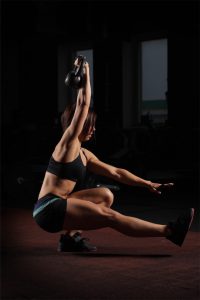Rotational Strengthening : The Future of Rotator Cuff Exercises
 The shoulder is one of the most commonly injured joints in the body. This is due to the complex arrangement of the surrounding ligaments and tendon muscle groups that are needed for, first , stabilization of the joint, and second, for providing a coordinated movement of the shoulder at varying velocities of acceleration and deceleration. Unlike the hip joint, which includes a bony socket for stable support, the shoulder lacks a bony socket and relies solely on the surrounding muscles, tendons, and ligaments for support and stabilization.
The shoulder is one of the most commonly injured joints in the body. This is due to the complex arrangement of the surrounding ligaments and tendon muscle groups that are needed for, first , stabilization of the joint, and second, for providing a coordinated movement of the shoulder at varying velocities of acceleration and deceleration. Unlike the hip joint, which includes a bony socket for stable support, the shoulder lacks a bony socket and relies solely on the surrounding muscles, tendons, and ligaments for support and stabilization.
The rotator cuff is a group of small muscles and their tendons that act to stabilize the shoulder. Moving the shoulder requires the coordinated contraction of all muscles of the rotator cuff simultaneously while permitting the larger power muscle group, such as the deltoid and pectoral muscles, to provide the needed acceleration and torque when engaged in any type of throwing or swinging activity. Sports that place high demands on such coordinated efforts include baseball, tennis, gymnastics, volleyball, and waterskiing , just to name a few. These activities require a flexible and properly functioning shoulder over a wide range of motion while performing in a safe, and effective manner. This tremendous range of motion renders the shoulder extremely unstable , far more prone to dislocation and injury than any other joint in the body. Essentially any activity that requires the use of the arm needs a stable shoulder in order to function. These may be anything from hanging a jacket on the coat rack or reaching to the back of the car seat getting the grocery bag.
Shoulder exercises are typically intended to strengthen the shoulder. These aim to improve athletic performance; to prevent injury; or to rehabilitate the shoulder after injury or surgery. The most basic device used in strengthening of the shoulder is the dumbbell. Free-weights allow front-to-back, up-and-down, or side-to-side motions. The larger power muscles are strengthened while the smaller stabilizing muscle groups of the rotator cuff are difficult to target. Elastic rubber bands and cable weight systems function similar to free-weights. That is, unidirectional strengthening of muscle groups in a primarily concentric mode. By changing the direction of how the weights are lifted, or which direction the elastic band is pulled, a person may target some specific rotator cuff muscles. However, these movements only work on a few muscle groups at a time in a unidirectional manner. There is minimal eccentric training (what is and the level of intensity of workout remains about the same throughout the exercise period.
Other devices that utilize vibration techniques require the coordinated efforts of many muscles groups and has the benefit of allowing the individual to vary the intensity of workout while in the midst of doing the workout by varying the speed or magnitude of oscillation of the device. Being focused as a total body workout in a unidirectional mode, i.e. side-to-side or up-and-down, it does not selectively train the rotator cuff in three dimensions.
Gyroscopic-like hand-held devices primarily strengthen the wrist and forearm. Without the wrist being immobilized, the resistance force is directed to the hand, wrist , and forearm via the gripping force that is required while holding onto this device. The rotator cuff muscles are not isolated for dedicated strengthening.
Upper body bicycle-like freestanding machines are non-portable, cumbersome, and restricts the arm to one motion only. The force required to rotate the hand-peddle is concentrated in the hand, wrist, forearm and elbow rather than the rotator cuff.
The ShoulderSphere isolates and trains the rotator cuff via two unique features – the rotating ball within the sphere and the splint attachment. Exercise motion is rotational rather than linear; it is three dimensional rather than uni-planer. The intensity of exercise can be varied in the midst of workout by varying the speed at which one spins the ball. Since the splint eliminates any rotational movement from the wrist , any rotational movement of the ball within the sphere is generated by the shoulder rotator cuff muscles. The elbow motion of up-and-down does not make the ball spin. In order to spin the ball effectively, all the rotator cuff muscles surrounding the shoulder must concomitantly contract in a synchronous manner – to “rotate” the shoulder. This instantaneous activation and deactivation of opposing muscle groups responding at a rate of four to eight times per second strengthens the rotator cuff both concentrically and eccentrically. Shoulder proprioception is enhanced by this improved reflex and control of the rotator cuff.
The ShoulderSphere rotator cuff strengthening technique demands concentrated coordinated contraction from all the surrounding shoulder muscle groups in a three dimensional fashion.
This paradigm shift of rotational exercise methodology is the future of rotator cuff strengthening.